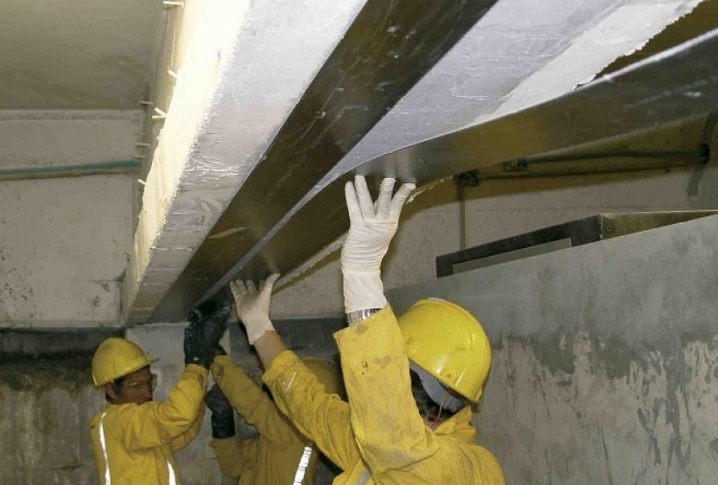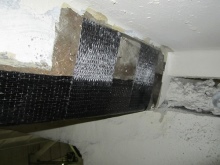All About Carbon Fiber Reinforcement

Strengthening a structure is one of the main (if not the most basic) stages of any construction process, which is associated with stabilization and an increase in the overall strength of the structure. Reinforcement of structures with carbon fiber is a technology that is a little over 20 years old and is rightly considered progressive.

Peculiarities
This simple, but super-effective method has an impressive list of advantages, which are explained by the properties of the material. To carry out reinforcement actions, you do not need to use special equipment with high lifting capacity, since carbon fiber is lightweight. The work itself is carried out 10 times faster than other technologies. At the same time, carbon fiber not only makes the structure stronger - it also improves the bearing capacity.
Carbon fiber is polyacrylonitrile (heat treated). During the reinforcement, the fiber is impregnated with a two-component epoxy resin, after which it is fixed to the surface of the object itself. The same epoxy resin demonstrates very effective adhesion to reinforced concrete, and when a chemical reaction occurs, carbon fiber becomes a tough plastic that is 6 or even 7 times stronger in strength than steel.
Carbon fiber is also valued for the fact that it is not afraid of corrosion, resistant to aggressive environmental factors... The mass load on the object does not increase, and the amplifier is capable of operating for 75 years or more.


Carbon fiber requirements:
- the fibers should be parallel;
- to preserve the structure of the reinforcement elements, a special fiberglass mesh is used;
- carbon fiber is produced strictly according to technology requirements and meets quality standards.
Among other remarkable properties of the material is the protection of the structure from moisture. Fiber does an excellent job of creating a dense waterproof layer. It is a high strength material, when it comes to tensile characteristics, the value of carbon fiber reaches 4900 MPa.
They are also attracted by the simplicity, the really high speed of the installation process, that is, any object can be strengthened in a short time, without spending money on equipment rental and calling a large number of specialists. And these savings in labor costs, time and money resources make carbon fiber a top product in its segment.
The effectiveness of carbon fiber reinforcement technology should be noted separately. It will be such if several conditions are met: this is the natural humidity of the structure, which does not interfere with the very possibility of installing the reinforcing material, and the reliability of fastening, and the properties of both fiber and glue that are stable in terms of time parameters.


Where is it applied?
The main direction of application is the reinforcement of reinforced concrete structures. The fiber is laid on those sections of the structure, which have the greatest stress.
What grounds for strengthening building structures can be distinguished:
- physical aging of the object, actual wear of the material and individual structural elements (floor slabs, columns, etc.);
- such damage to the concrete structure, which has reduced its bearing capacity;
- redevelopment of the premises, in which adjustments are made to the bearing structural units;
- situations when there is a request to increase the number of storeys in buildings;
- reinforcement of structures dictated by the emergency and its urgent resolution;
- ground movements.



But carbon fiber interacts so well not only with reinforced concrete. The same applies to metal structures that have a modulus of strength and elasticity related to carbon fiber. You can also work with stone structures, such as pillars, brick walls of houses.
Wooden floor beams also need to be reinforced if the condition of the beam system requires intervention, if the bearing capacity is obviously reduced.
That is, carbon fiber is an excellent and multifunctional material for external protection of structures made of concrete, metal, stone, wood.


Reinforcement technology
Recommendations are the theoretical basis for a process that is not very laborious, but still requires attention to all the details.

Preparation of the base
Before starting the external reinforcement with carbon fiber, it is necessary to carry out structural markings, that is, it is necessary to outline the areas where the reinforcing elements will be fixed. Measurements are made together with cleaning the surface from the old finish, from the cement laitance. For this, an angle grinder with a diamond cup is used. Another option is a water-sandblasting machine. And the cleaning takes place until the moment when a large concrete aggregate is found.
All of the above actions require a very responsible execution, since the level of preparation of the base for reinforcement directly affects the final result. Work on the effectiveness of amplification begins with preparatory actions.
What you need to pay attention to:
- what are the characteristics of the integrity / strength of the material of the object to be strengthened;
- whether the surface where the carbon fiber will be mounted is flat;
- what are the temperature and humidity indicators of the surface, where the reinforcing material is fixed;
- whether there is dust, dirt at the place of adhesion, whether it is sufficiently cleaned before the forthcoming procedures, whether insufficient cleaning will interfere with the adhesion of the base and carbon fiber.


Of course, the calculation of the reinforcement of structures is also made, on the basis of which the work is carried out. This business should only be dealt with by highly qualified specialists. Of course, any independent calculations are fraught with unforgivable mistakes. Usually such problems are solved by the pros of design organizations.
To calculate the reinforcement of an object with carbon fiber, you need:
- the results of examinations and examination of the amplification objects themselves;
- high-quality, detailed photos of the object's surface;
- detailed explanations.
Calculation usually takes 1-5 working days, it depends on the demand for specialists, their employment, etc.


Preparation of components
Carbon fiber itself is sold in rolls packed in polyethylene. It is important that dust does not get on the reinforcement material during the preparation of the working surface. And it will - and most often during concrete grinding. If the surface is not dedusted, not protected from its ingress, the material simply cannot be impregnated with the substance - the work will be defective.
Therefore, before opening the mesh / tape, the working surface is always covered with polyethylene, and only then you can start measuring. To cut the hydrocarbon mesh and tape, you need to prepare either scissors for metal, or a clerical knife.
But carbon fiber in the form of lamellas is cut with an angle grinder with a cut-off wheel.


Compositions of two components serve as an adhesive, therefore you will have to mix these components yourself in the right proportions. In order not to disturb these proportions, weights must be used in the dosing process. The rule is iron, and it is this: the components are mixed smoothly, gradually combining, the mass is mixed with a drill with a special nozzle. Mistakes in this process can cause the adhesive to boil.
Important! On the construction market today you can find an adhesive material that is sold in two buckets. The required proportions of the two components have already been measured, they just need to be mixed according to the instructions.
Another tool that is taken in the process of preparing a mixture is a polymer-cement adhesive.
It is sold in bags, differs from the previous composition in that it is diluted with water according to the instructions.


Installation of materials
Installation technology depends on what type of material is chosen. The carbon tape can be attached to the base in two ways: dry or wet. Technologies have a common property: an adhesive layer is applied to the base surface... But with the dry method, the tape is attached to the base and impregnated with adhesive only after rolling with a roller. With the wet method, the same tape is initially impregnated with an adhesive compound and only then is rolled with a roller to the base to be treated.
Conclusion: these methods differ in the sequence of the installation process.


Installation features:
To impregnate carbon fiber with adhesive, a layer of this composition is applied to the surface of the fiber, passed with a roller, achieving the following: the upper layer of the adhesive goes deep into the material, and the lower one appears outside.
Carbon tape is also glued in several layers, but still you should not do more than two. This is fraught with the fact that when fixed to the ceiling surface, the material will simply slide under its own weight.
When the adhesive cures, it will be perfectly smooth, which means that finishing is virtually eliminated in the future.
Therefore, there is no need to wait for drying, but a sand layer must be applied to the newly treated surface.

When carbon lamellas are mounted, a binder is applied not only to the object to be reinforced, but also to the element to be mounted. After fixing, the lamella must be rolled with a spatula / roller.
The carbon mesh is attached to a concrete, initially wetted base. As soon as the adhesive is applied (manually or mechanically), immediately roll out the mesh without waiting for the adhesion composition to dry. The mesh should press slightly into the adhesive. Experts prefer to use a spatula at this stage.
After that, you need to wait until the composition initially grabs. And you can understand this by pressing - it shouldn't be easy. If the finger is pressed with great effort, then the material has seized.
And this serves as a signal that it is time to apply the finishing layer of polymer cement.


Protective coatings
The epoxy resin adhesive is flammable. Under ultraviolet exposure, it also risks becoming very fragile. Therefore, it is necessary to use such compositions with the provided fire protection of objects that are to be strengthened.
In general, the strengthening of a structure with carbon fiber is a progressive, from many points of view, an economical way to strengthen a structure and its elements.... Composites used for reinforcement are much lighter and much thinner than more conventional materials. In addition, external reinforcement is a versatile modern technique. It is used both at the stage of building construction and during repairs, during restoration work, that is, in order to strengthen the structure, in many cases it is not even necessary to suspend its operation.

Carbon fiber reinforces elements of residential and industrial buildings, architectural structures, transport and hydraulic facilities, and even nuclear facilities.
But those who believe that the use of new materials and technologies is always more expensive than traditional solutions are a priori mistaken in their calculations. The strength of the structures increases significantly, the building does not cease to be used during the repair (and this could cause financial losses of a more serious size), such repairs are very fast in time.
Experts estimate that the cost savings are around 20%.


You can learn how to reinforce boards with carbon fiber in the video below.







The comment was sent successfully.